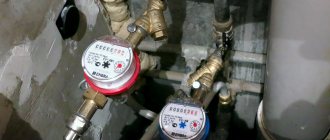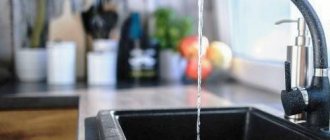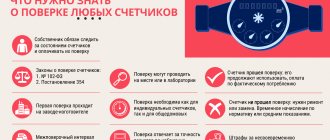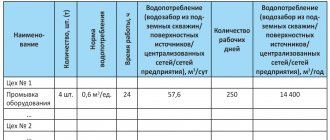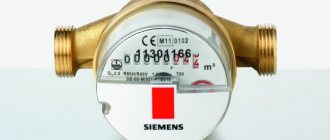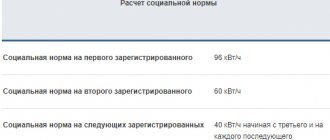The rate of water consumption per person per month is an annual problem that arises for a resident who still has not bothered to install consumption meters. If you have a meter, it is very easy to determine how much water is actually consumed per person in an apartment or in a private house connected to a central water supply or supplier. If there is none, you have to carefully monitor cold water standards, and if the supply is centralized, then every cubic meter of hot water counts.
Meters in the apartment
The legislative framework
Government Decree No. 354 provides information regarding the provision of housing and communal services. There are also formulas with which you can calculate the volume of water consumed. They differ depending on whether a water meter is installed in the apartment.
Over the past 30 years, there have been no changes in water consumption standards. However, these values vary depending on the type of residential building.
Prices for 1 m3 of water are set by local authorities in all regions. In this case, the norms from Federal Law No. 210-FZ must be taken into account.
Water consumption standards are regulated in the following situations:
- if there are no common meters in a residential building;
- if the deadlines for sending data are not met and several months in a row are missed (more than six months);
- when the tenant refuses to provide water meter readings;
- in case of malfunction of the metering device and the need to replace it.
Such laws are aimed at ensuring that citizens install flow meters. Otherwise, they will have to pay fixed rates, which could result in actual costs being several times higher.
Standard cold water per person without the use of a water meter
Before water standards per person were introduced, general house flow meters were installed. With their help, the amount of water consumed by the residents of the entire house was determined. This amount was then divided by the number of apartments in the building. This method was not entirely fair for the population, since some people spent less resources, while others spent more.
Therefore, standards were introduced. For one person over a thirty-day period, the standards for cold water are 6.935 m3. If you divide this amount by 30, you get approximately 200 liters of water for one day. To make it clearer, the volume of a standard bath is about 250 liters. Not all people take it daily. Therefore, we can conclude that these standards are very high, even if a person uses plumbing every day.
Moreover, utility companies have the right to increase this standard to cover costs, but not more than 2 times. In this case, the service fee will be even higher.
About social norms for water consumption
When obtaining the standard value, the natural needs of the population, which require the use of water, were taken into account. These include the following:
- Washing in the shower. This requires about 30 liters of water per day.
- Washing, shaving and other daily needs. A person spends about 200 liters per week on this.
- Going to the toilet. On average, a person uses up to 200 liters per day when flushing the toilet cistern. If the plumbing leaks, costs can increase to 260 or more liters. In this case, the costs will be even more impressive.
- Taking a bath. This takes up to 400 liters per week.
- Cooking, washing dishes, cleaning, laundry. This requires another 500 liters per week.
- The cost of water required to maintain the house is also included. For example, washing common areas, entrances and others.
- Other expenses. Approximately 800 liters per year are allocated for them.
Taking into account all the above needs, a number was obtained that is the norm for water consumption per person per month. Almost 7 m3 is quite enough, even if you don’t save water. In many cases, consumption does not even reach the norm.
Important! The maximum rate of water used in 30 days should not exceed double the rate. That is, utility companies cannot demand payment for more than 14 m3 over a thirty-day period. Otherwise, you can complain about them.
Payment for the resources provided is taken for each person registered in the house, even if he does not live here. Persons with temporary registration are also taken into account.
In the absence of a water meter, there is no need to save, since the payment is fixed. However, even without savings it will be difficult to reach the applicable standards. Therefore, this option is less preferable.
If a water meter is installed, costs are determined for each apartment separately, depending on the amount of liquid flowing through the water pipes.
There are also monthly standards for wastewater disposal. They amount to 11.68 m3 per person. This includes the costs of DHW and cold water. Utilities also have the right to raise this value.
Payment for housing and communal services without registration
Those citizens who do not have constant access to the Internet can use modern methods of paying for housing and communal services without registration. If you have a bank card, you can pay money through an ATM.
To do this you need:
- in the main menu select “Payment for services”;
- register the recipient among a number of options offered by the ATM;
- enter your personal account, which can be viewed on any receipt;
- set the payment period;
- execute the “Pay” command.
The required amount of funds will be immediately withdrawn from the plastic card. The ATM will definitely give the user a receipt, which must be kept to confirm the validity of the payment.
Today, payment terminals are available to a wide range of consumers. This method of debt repayment can be used even by those citizens who do not have a bank card. Payment at the terminal does not require registration. Using the system prompts, you can quickly select the direction of payment, enter the recipient’s details and personal account. Terminals also issue checks, which are legally equivalent to receipts from official structures.
What are multiplying factors?
If there are no flow meters, but their installation is possible, so-called increasing factors apply. That is, the payment for water increases slightly - for 2021 it is 1.5. This law was introduced in 2021, and in accordance with it, household expenses are increasing.
This measure was introduced to ensure that citizens of the country install meters in their apartments. It is also necessary to install common house appliances necessary to control the amount of water used throughout the house.
Formulas for calculating water consumption
The amount of resources used is calculated using special formulas. The final cost of payment will depend on the temperature of the liquid, as well as the presence or absence of a water meter. The formulas are developed by the legislation of the Russian Federation.
There is no technical possibility to install the device
If it is technically impossible to install a meter in an apartment, then the formula for calculating water will look like this:
P = n*N*T, where:
N – standard cold water per person per month (may vary by region and service provider);
n – the number of people officially living in the house (tenants with permanent and temporary registration);
T is a fixed tariff for paying for water without a meter, which is valid within the region under consideration.
Installation of a water meter is possible
If a water meter is not installed, but there are no technical obstacles to this, the water tariff increases. It will be 1.5 times larger, unlike those who have installed water meters. Therefore, one more component will be included in the formula. As a result, the price will be calculated as follows:
P = n*N*T*K, where:
n – the number of residents who have temporary or permanent registration in a given premises;
T – water tariff;
N – water norm per person per month;
K – increasing coefficient.
Thus, it turns out that it is much more profitable to install a water meter. Payment will be made according to how much water was used over the past month. While for people without a meter, the amount to be paid will be calculated based on the water norm for a thirty-day period.
Attention! It is imperative to keep track of when the check date for water consumption meters expires. After all, if you delay sending the water meter data by 6 months, the calculation can also be carried out according to the standard.
Features of water supply rationing in rural areas
For rural residents, water rationing occurs if consumption comes from the central pipeline. If water intake is carried out from local installed water pumps, then there are rules established by the local authorities.
If there is a meter, payment is according to the tariff. If there is no meter, then the norms will be as follows: 4.2 cubic meters per person per month. But these data are also averaged, since each region has its own standards.
As for private houses in rural areas, as a rule, the calculation is carried out here taking into account a number of features, ranging from the area of the plot to climatic features.
DHW standard without water meter
The rate of hot water per person for a thirty-day period is lower compared to cold water and amounts to 4.745 m3. Also, utility companies have the right to increase this norm (but not more than 2 times) if there is a cash shortage. Therefore, the norm is 4.745 x 2 m3. The amount of water spent in winter for heating is calculated separately.
Attention! It doesn't matter if someone lives in the apartment. Owners will have to pay the amount of services according to the standard, with mandatory consideration of how many persons are registered in the premises.
Based on this, one person should consume no more than 13-140 liters of hot water per day. However, you can spend resources without saving them - regardless of actual consumption, the calculation cannot be more than the established standards.
Payment of utilities without a receipt
Today, to pay for housing and communal services, it is not at all necessary to have numerous receipts with you. It is possible to repay the debt without waiting for payments from housing and communal services, which often arrive late. Using your own personal account and special online services, you can find out all the necessary information about the status of payments or overpayments.
Payment can be made directly through the banking organization with which the consumer has an agreement. After sending a message with payment information, you must wait for a response from the bank. To confirm the transaction, you need to indicate the deduction amount and send another SMS. After this, the bank will be able to independently debit funds from the client’s credit card and successfully transfer them to the recipient’s account. If there is a valid subsidy, the discount will be automatically taken into account when transferring.
Standards and tariffs by city for 2019
The above standards are an average. However, this indicator differs for different regions of Russia. Also, these values may vary depending on the type of house - they differ for private and multi-apartment buildings. Tariffs vary depending on the territory.
Let's consider the prices for water set in different cities of Russia. All the necessary information is presented in the table below.
| City | HVS | DHW | ||
| m3/person | rub. per 1 m3 | m3/person | rub. per 1 m3 | |
| Moscow | 6,935 | 38,06 | 4,745 | 188,53 |
| Saint Petersburg | 5,36 | 25 | 3,89 | 100 |
| Novosibirsk | 5,193 | — | 3,687 | 89,11 |
| Krasnodar | 4,04 | — | 2,65 | — |
| Ekaterinburg | 5,62 | — | 5,04 | — |
| Ufa | 6,365 | 12,5 | 2,582 | 57,2 |
| Rostov-on-Don | 6,5 | — | — | — |
| Chelyabinsk | 4,25 | — | 3,11 | — |
| Voronezh | 5,1 | — | 3,07 | — |
| Permian | 5,6 | 31,6 | 3,4 | 152,2 |
| Kazan | 6,73 | — | 3,44 | — |
| Samara | 7,9 | 27,1 | 3,6 | 130,2 |
In places where a dash is indicated, the exact data is unknown.
Attention! Actual prices may vary slightly from those shown above. This depends on the utility provider.
Climate zone
<
This criterion is taken into account not only for actual water consumption, but also when determining general standards in Sanitary Rules 2.04.02-84 (see table), which states that lower values are accepted for northern regions, larger ones for southern ones. The difference between them is 28, 44 and 52%.
How to save water in an apartment
When a water meter is not installed, people pay much more than they actually spend. After all, the standards established by law are very high and do not correspond to the real needs of consumers. Such standards are established to compensate for water losses, which can be caused by various reasons (accidents, worker negligence, etc.).
For example, a pipe burst, it was not immediately noticed, and then it was not immediately repaired. As a result, water flowed freely for several days. The loss of resources can be very significant. And payments for the negligence of workers will be made by the residents of the house - the water standard can be increased by 2 times.
In reality, the amount of water used per month is 2-4 times lower. Even if you do not save water, its consumption reaches 4 m3 of cold and 3 m3 of hot.
Therefore, it is much more profitable to install a water meter. This way it will even be possible to reduce the consumption of water resources, avoiding unnecessary waste. Due to this, you can save a lot. Moreover, the savings can be quite impressive - up to several hundred rubles per month per person. And if several persons are registered in the apartment at once, then this amount increases a couple of times.
There are a number of simple rules that will help save consumed resources:
- Take a shower, not a bath. If you fill the bathtub to the top, up to 200 liters of liquid will be lost at a time. According to statistics, much less water is wasted when taking a shower - up to 50 liters.
- Try to be in the shower less. You don't need to take a long shower in the morning to perk up. You can do this by drinking a cup of coffee. Moreover, it is necessary to take into account that prolonged exposure to hot water can negatively affect the condition of the skin.
- Run the dishwasher with a full load. If you fill it only halfway, a lot of excess liquid will be wasted. And for maximum savings, you can wash dishes in a basin.
- Run only a filled washing machine. But you shouldn’t overcrowd it, as this could quickly cause the device to fail. It is recommended to use modern washing equipment. New machines use 50% less water than older models.
- Install a wastewater recycling system. Purified water can be used to water flowers, wash areas, and so on.
- Monitor the functioning of plumbing fixtures. If a leak is detected, it must be repaired immediately. For example, a leaking toilet can generate up to 16,000 excess water per year.
- Turn off the tap while brushing your teeth and turn it on only to wash your toothbrush.
- Place the filled bottle into the toilet cistern. This method will allow you to save a lot of money.
- Use an economical toilet flush. Usually there are two buttons on the drain tank - one larger, the second smaller. You need to press the small one so that less liquid is drained.
- To wash your car, use a bucket of water rather than a hose. And then, to rinse, you can water the car with a hose.
It is also recommended to check your water meter readings regularly. This will allow you to monitor the amount of water used. These simple steps will help you use less water and lower your monthly utility costs. But it’s wiser to save hot water, because cold water costs a penny.
Thus, charging for water using a water meter is much more profitable than charging according to standards. Indeed, in this case, residents pay only for the resources used, regardless of the number of people registered in the apartment. Installation of the meter is carried out at the personal expense of the owner of the premises. In houses with a single central riser, it is enough to install two devices - separately for hot water supply and hot water supply. If you live in an apartment building where there are two central risers, you will have to install 4 meters - two for hot water supply and two for hot water supply.
After installing the device, you will need to call a housing and communal services representative to complete the accounting. As a result, you will have to spend money on installing the meter. However, in the future, all costs will pay for themselves through savings on utility bills. The greatest savings will be observed in the summer, when many people go to the country. But if there is no meter, you will have to pay a fixed amount, even if there is no one in the apartment for an extended period of time.
Pros and cons of installing a water meter
Today, by law, every apartment or private residential building must have a water meter. But not everyone agrees to install it. After all, residents have to buy and install devices that take into account the flow of hot and cold water at their own expense. In addition, they must be regularly checked. And this service is also paid. Sometimes problems arise in the operation of metering devices and they have to be repaired. This all again affects the family budget.
Among the disadvantages, many include the need to take monthly readings and transfer them to utility services. This must be done on certain dates. And residents often forget about this. As a result, you have to pay according to average readings and seek recalculation. This is an extra waste of money, time and nerves.
But in general, using a water meter for citizens of the country is relatively cheap. And, if you follow a number of recommendations, you can save a lot on utility bills.
The main advantages of using water meters are given below:
- Payment is made for the water actually consumed. It is half as much as without a meter.
- You don't have to pay for hot water, which is expensive. To do this, you need to install a water heater.
- There is no need to pay for water if you are temporarily away from home. For example, if a family went on vacation for a couple of weeks, decided to live not in an apartment but in a country house in the summer, or went on a business trip for a long time.
- There is no need to pay for your home's overuse of water.
It should be noted that the installation of water consumption metering devices does not reduce the actual water consumption of the residents of the house. But it allows you to significantly reduce financial costs for utilities. The costs of purchasing, installing and maintaining meters are not that big. Therefore, apartment owners feel the benefit in any case.


